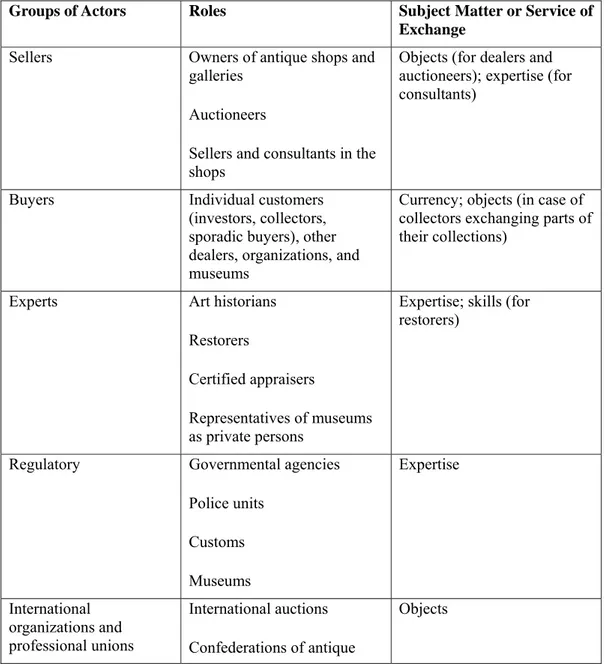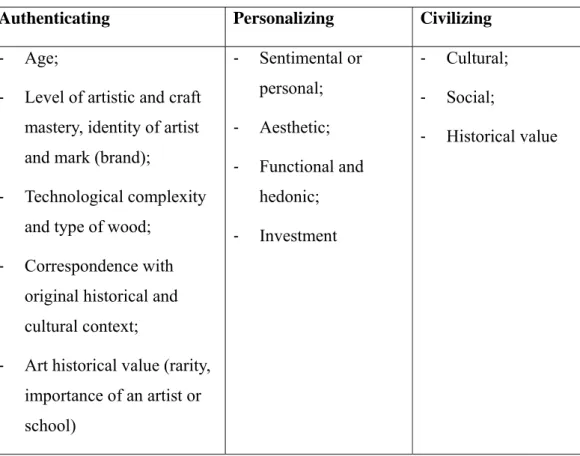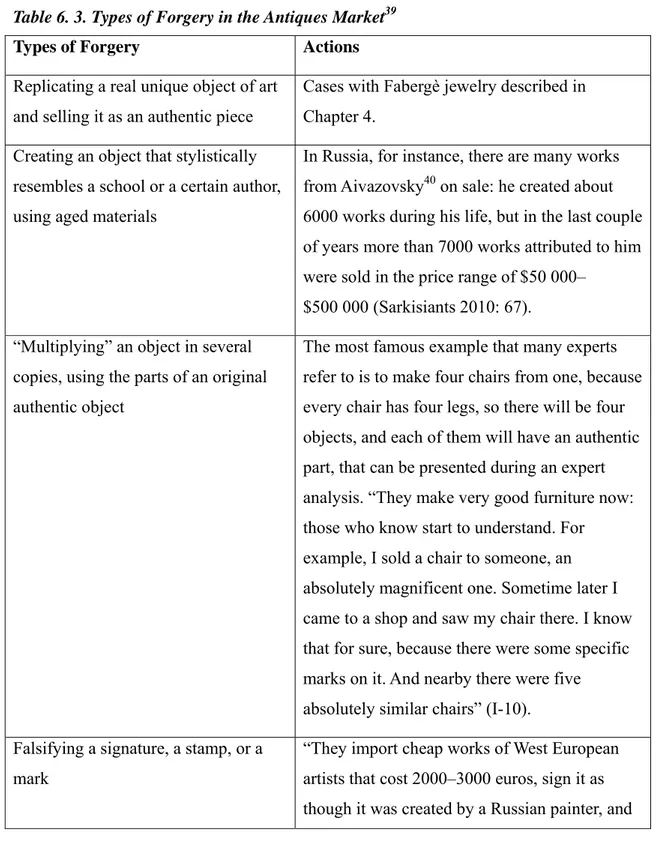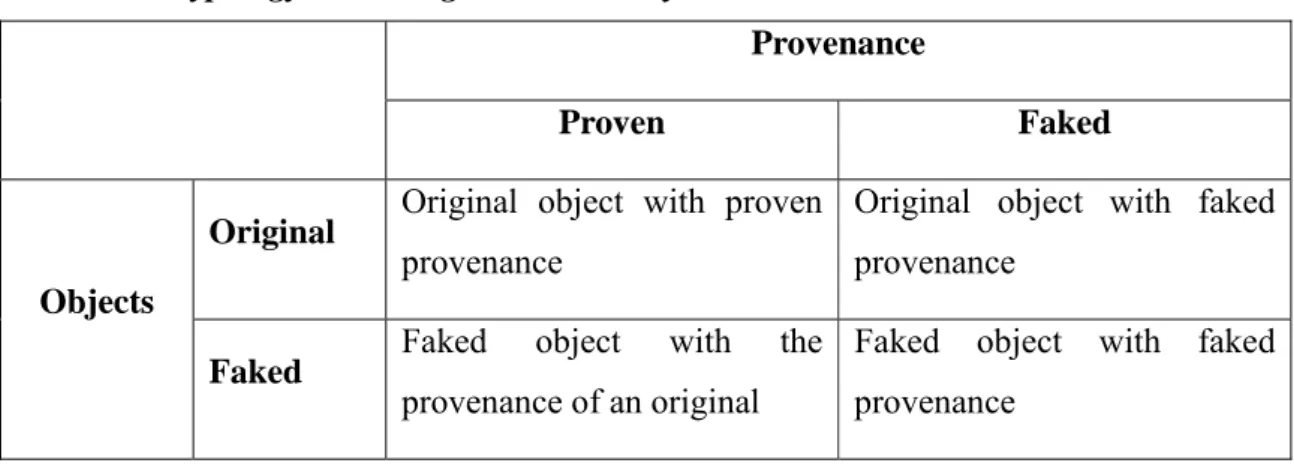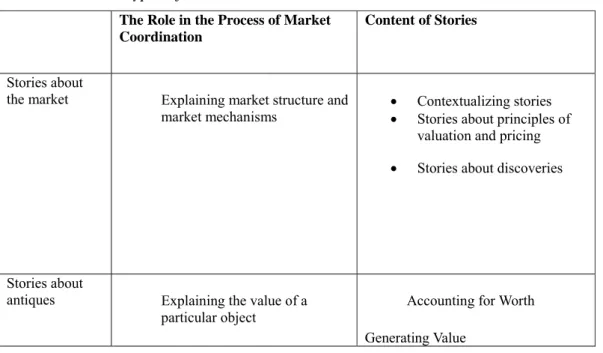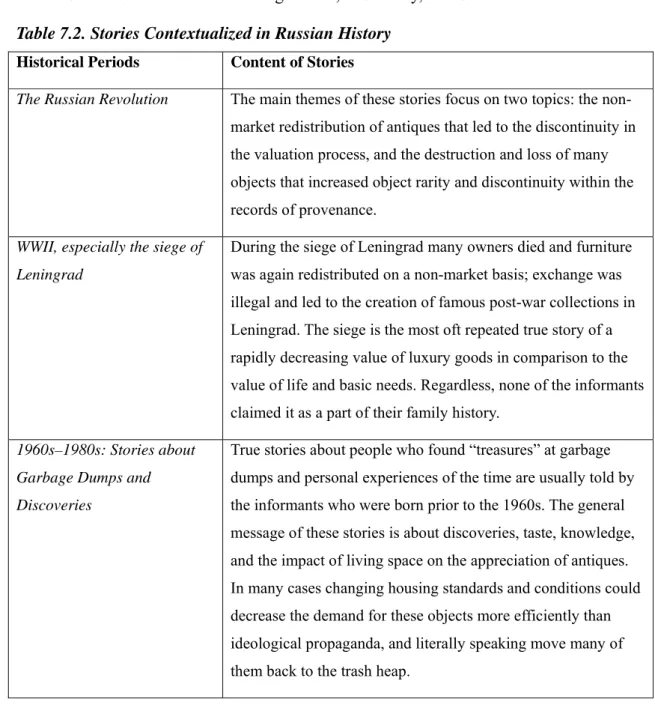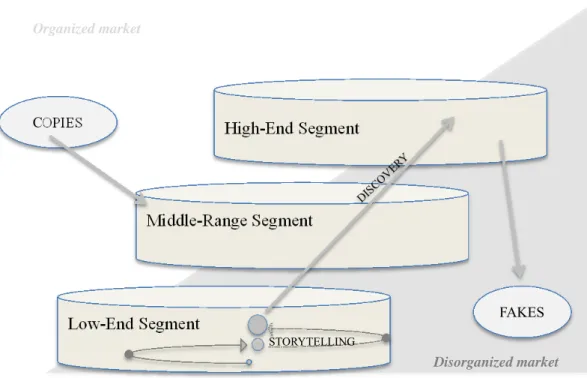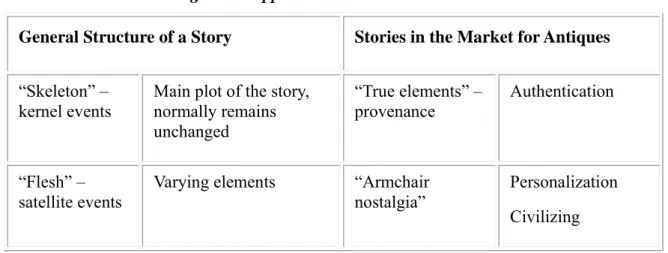VALUING THE PAST:
THE CONSTITUTION OF THE ANTIQUES MARKET IN RUSSIA
Inauguraldissertation zur
Erlangung des Doktorgrades der
Wirtschafts- und Sozialwissenschaftlichen Fakultät der
Universität zu Köln
2011 vorgelegt
von
Elena Bogdanova aus
Ulyanovsk (Russland)
Referent: Prof. Dr. Jens Beckert
Korreferent: Prof. Dr. Sigrid Quack
Tag der Promotion: 8 Juli 2011
List of Tables ... vi
Acknowledgments ... vii
1. Introduction ... 1
1.1. Research Question and Theoretical Framework ... 3
1.2. Case Selection and Methodology ... 5
1.3. Organizational and Methodological Constraints of the Research ... 7
1.4. The Structure of the Thesis ... 8
2. The Value of the Past: The Emergence and Development of Interest in Antiques in Western Europe ... 14
2.1. Bringing the Past into the Present: The Evolution of the European Concept of Antiques and Their Value ... 15
2.1.1. Early Forms of Sacral, Social, and Material Values of Antiques ... 15
2.1.2. Renaissance Mentality and the Birth of a Systematic Understanding of Antiques as Old and Rare ... 20
2.1.3. The Spread of Interest in Antiques Across Europe in the Seventeenth and Eighteenth Centuries ... 23
2.1.4. The Beginnings of a Systematic Study of the Past: Classifications and Styles in Archaeology and Art ... 24
2.1.5. Trade and Sentiment: The Antiques Market in Nineteenth Century Europe ... 26
2.1.6. Antiques as a Part of Civilization Processes ... 29
3. Social and Political Transformations in Russia and the Value of Antiques .. 33
3.1. Specificity of Russian Art and Antiques: Borrowing and Adapting ... 33
3.2. The Antiques Market in Russia in the Eighteenth and Nineteenth Centuries .... 35
3.3. The Russian Revolution and the Establishment of State Control of the Antiques Market ... 39
3.3.1. Accounting for Culture: Nationalization and the Sale of Art and Antiques in the 1920s ... 42
3.3.2. Industrialization at the Expense of Culture: Turning Rembrandts into Convoys of Tractors ... 45
3.3.3. Future‐oriented Ideology and Memory Crisis ... 46
3.4. Antiques and Their Value During WWII ... 49
3.5. Khruschev’s Housing Policy, the “Thaw” Ideology, and The Fight With Meschanstvo: The Socialist Lifestyle vs. Antiques ... 50
3.6. The Emergence of the Illegal Antiques Market in the Soviet Union ... 52
3.7. Rehabilitation of the Past and the Return of the Market in the 1990s ... 54
4. The International Market for Art and Antiques: Structure and Main Characteristics ... 57
4.1. Assessing the Financial Attractiveness of Art and Antiques ... 59
4.2. Prices and Economic Cycles: Art and Antiques as Alternative Investments ... 60
4.2.1. Returns on Investments in Art and Antiques: Methodological Challenges for Measuring the Worth of Art Objects ... 61
4.2.2. Creating “Market Baskets” as a Method of Value Accounting ... 63
4.2.3. Value Regressions for Single Objects ... 64
4.3. The Attractiveness of Investments in Art and Antiques from a Comparative Perspective ... 66
4.5. The Role of Incomplete Information in Market Coordination ... 76
5. Beautiful and Dangerous: An Empirical Study of Antiques Market Coordination in Russia ... 79
5.1. The Antiques Trade as an Illegal Market in the Soviet Union: Main Features, and Consequences for the Contemporary Market ... 80
5.1.1. Structural Preconditions of the Antiques Market in the 1990s ... 81
5.2. The Structure of the Contemporary Antiques Market in Russia ... 83
5.3. Market Actors ... 89
5.3.1. Buyers ... 91
5.3.2. Dealers ... 95
5.3.3. Experts and Institutions of Expertise ... 96
5.4. A Fight over the Market for Expertise: Museum Brands vs. New Institutions ... 99
6. Changing the Value of the Past: An Empirical Study of the Valuation of Antiques ... 102
6.1. Formal Criteria for Defining Antiques ... 102
6.1.1. “The Past that is Over”: Temporal Definitions of Antique ... 103
6.1.2. Levels of Artistic Mastery and Rarity as Criteria for Antiqueness ... 104
6.2. What Else Matters? The Typology of Value ... 107
6.3. Authenticating Antique Objects: the Field of Technical Expertise ... 111
6.3.1. Acquaintance with Tools and a Knowledge of Woods: Technical Authentication ... 112
6.3.2. Artist Names as the Markers of Authenticity ... 114
6.3.3. “Biography of a Chair”: Research in Provenance as a Part of the Authentication Procedure ... 115
6.4. What is the Value of Authenticity: Stylistic Reproductions and Copies on the Market ... 117
6.4.1. Replicating the Masterpieces: Creating Valuable Copies ... 117
6.4.2. Modern Copies and Replicas: Technology vs. Mastery ... 118
6.4.3. Ties to the Past: Originals, Copies and Stylistic Reproductions as Competing Products in the Market for Antiques ... 119
6.5. Types of Fakes and Forgery in the Market ... 121
6.6. “Reincarnated Signs”: Personalizing Antiques ... 128
6.7. “Civilizing” People: The Positional Value of Antiques ... 129
6.7.1. Champagne Fountains and Gold vs. Art Deco ... 130
7. Valuation in the Russian Antiques Market: Building Institutions, Preserving Networks and Telling Stories ... 133
7.1. The Antiques Trade as a Quest for Adventure ... 133
7.1.1. How to Embark on a Quest: Market Rules and Practices ... 134
7.1.2. Forgery: an Evil and a Functional Good ... 137
7.2. Increasing Uncertainty? The Danger of Dissemination of Professional Knowledge ... 140
7.3. Networks and Stories vs. Institutions and Expertise ... 142
7.3.1. From Singular Objects to Singular Clients: Creating a Mystery for Everyone ... 145
7.4. Storytelling as Worth Accounting ... 146
7.4.1. Market Stories ... 147
7.4.2. Storytelling: Generating Imaginative Value ... 152
8. The Cognitive Embeddedness of Valuation ... 157
8.1. Antiques as a Representation of Social Order ... 157
8.2. Schemata and Interpretation: How an Antique’s Value Becomes Imaginative 165
8.3. Justifications and Conventions ... 167
8.4. Stories and Discourses: Combining Classifications and Interpretations ... 170
8.5. Uncertainty, Ambiguity, and Confidence ... 173
9. Conclusions ... 176
9.1. Valuation: History, Transformations, and Cognition ... 177
9.1.1. The Importance of the Past ... 177
9.1.2. Uncertainty and Ambiguity ... 179
9.2. Questioning the Russian Antiques Market ... 179
9.2.1. Networks and Institutions ... 180
9.2.2. Uncertain Product Quality Meets the Uncertain Quality of Expertise ... 181
9.2.3. Reputation and Competition in the Field of Attribution ... 182
9.2.4. Exploiting Uncertainty, Promoting Ambiguity ... 183
9.2.5. Creating Discoveries, Telling Stories ... 184
9.3. Beyond Antiques: What Can We Learn From This Study of Other Markets? .... 185
9.3.1. Transformative Context ... 185
9.3.2. Singularities ... 186
References ... 189
Appendix 1. List of Informants ... 198
Appendix 2. Main Questions and Topics for Interviews with Experts ... 200
Appendix 3. Main Questions and Topics for Interviews with Ordinary Buyers
... 201
List of Tables
Table 5.1. Main Groups of Actors in the Russian Antiques Market 89 Table 5.2. Types of Buyers in the Russian Antiques Market 94 Table 6.1. Types of Worth as Expressed by Informants 106 Table 6.2. Valuation Processes: Authenticating, Personalizing and Civilizing 110 Table 6.3. Types of Forgery in the Antiques Market 123 Table 6.4. Typology According to Authenticity 125
Table 7.1. Main Types of Stories 146
Table 7.2. Stories Contextualized in Russian History 147
Table 8. 1. Stories as Cognitive Supports 172
Acknowledgments
Many thanks to the Max Planck Institute for the Study of Societies, the long journey to completing my dissertation is over. I am very grateful to Jens Beckert, my academic supervisor, who gave me the chance to write this thesis, and who shared with me valuable comments and ideas. When I started my project Sigrid Quack was in charge of guiding my cohort through the process of writing proposals; she was also the one who helped me a great deal by providing comments at the final stage. I would like to thank the members of my academic committee, Patrik Aspers and Michael Hutter for commenting on drafts of the manuscript. Discussions with Brooke Harrington, Guido Möllering, Sascha Münnich and Raymund Werle were very fruitful. They always had good ideas and rescue plans when the need arose. Many researchers who stayed at the institute at different points over the years generously spent their time and efforts in discussions about what ended up becoming this thesis.
This research project crystallized during my stay at the Center of Organizational Innovations at Columbia University in New York, where I was a visiting scholar in the Fall 2009. I am endlessly indebted to David Stark for insightful discussions at the seminars in Economic Sociology and at other COI meetings. My meetings with Charles Smith and Harrison White helped to sharpen several arguments. It was a great pleasure to practice sociological imagination together with the graduate students at the Department of Sociology, and in communications with professors. My special thanks to Raul Barosso for his academic optimism and the discussions we shared at Knox Hall.
My warmest thanks to Hellen Callaghan, Ipek Göcmen, Thorsten Kogge, Olga Malets,
Sabrina Zajak, Irene Troy, and Azer Killiç for helping, sharing, and enjoying nice times
together in Cologne. Our American reunions, Alpine experiences, and Cologne Karnival
were incredible. I am grateful to all of the doctoral fellows at the Institute for stimulating
academic conversations and the free time we spent together. The Institute's
administration, library, IT service, and publishing office have continued all these years to
be the invisible hands of academia, facilitating the perfect working conditions. Their
problem-solving abilities and unbelievable friendliness were very helpful.
mind during the much needed breaks. I would like to thank my friends and teachers all over the world, for practicing aikido with me. I am grateful to the Members of Forum Kishintai in Cologne, and its affiliates, who kindly taught me how to land softly.
Wolfgang and Helga Sodeur became my German family and provided me with emotional and organizational support starting from my very first days in the country. I also owe to them my love for Cologne.
We all have history. Back to the days in Russia; I would like to thank my professors from Ulyanovsk State University and the European University at Saint Petersburg for giving me the right books to read, and for introducing me to the ideas that I really appreciated while writing my thesis. I am personally grateful to Daniel Alexandrov, Igor Kalinin, Oleg Kharkhordin, and Vadim Volkov. I shared an invaluable experience with my colleagues and students from National University – Higher School of Economics in the days when we started the Chair of Sociology at the Saint Petersburg campus. As is everything in post-Soviet Russia, it was a new, turbulent, and exciting time. Since those days my friends and colleagues Natalia Danilova, Tatiana Golova, Olga Gourova and Anna Likhtenstein have always been open for insightful discussions and are there to help.
Using all means of communication, Maria Nozhenko, Maria Batygina, Dmitry Chernyaev, Evegeny Chistyakov, Tatiana Saikhanova, Elena and Lidia Kleshchenok, and Oksana Zhironkina were a part of my life all these years and have always welcomed me back to Saint Petersburg.
I would also like to thank my anonymous informants in Russia and Europe, dealers and experts, active and retired, for their trust and willingness to share their knowledge with me. These interviews were possible because of the generous help and efforts of my friends, colleagues, and strangers, who care. Many thanks to Nicole De Cuir who helped me with the language corrections on the final draft.
Finally, but most importantly, this thesis would not be possible without my grandmothers,
Zinaida and Alexandra who taught me reading by the age of three. My parents, Tamara
and Vladimir Ashlapov have been the loving listeners, critics, and my best friends all this
time. I always smile when I think about my brother Mikhail, whose sense of humor and
joyfulness always lightens up life. And I want to thank Marijan Sprem for his emotional
1. Introduction
In one of his short stories, The Parson’s Pleasure, Roald Dahl describes an antique dealer, who travels the countryside in search of valuable antiques. The dealer’s main goal is to persuade the owners of such objects that they are worthless and to then sell them later in his London shop at a higher price. This story about unappreciated treasures is not just a work of fiction. In recent years, treasures, which were discovered in attics, have often been sold at the largest antique auctions in Europe and in the US. On a more conventional level, the Antiques Roadshow, a television show that is popular in many countries, relates stories of luck and disappointment. It depicts undervalued stockpiles of antiques collected by families in different countries, which for some reason have long gone unappreciated in terms of their market worth. But, how did these objects become so valuable on the antiques market? Who is interested in antiques, and for what reasons? And finally – how do dealers and antiques experts manage to persuade large groups of people that these objects are really valuable?
As objects from the past have grown in value, a market for antiques has emerged that is
continually changing and developing. Antiques are not produced for the market – they are
rediscovered, which means that their quality is not standardized. This raises the question
of how incommensurable goods such as antiques are valued, when their quality is
uncertain. In this thesis I use an empirical study of the market for antiques in Russia in
order to find out. The process of valuing antiques that involves appraisal and attribution is
an ambiguous one: market actors need specialized knowledge in the field of decorative
art and art history in order to make the correct judgments. Discontinuities in historical
records mean that this specialized knowledge is often open to debate. What is more,
specialized knowledge may be inaccessible to some market actors, or be too difficult for
them to grasp in order to be able to make proper use of it. The past has to be taken into
account, but it is also inherently uncertain. Thus actors in the antiques market have to
cope with more than the traditional problem of uncertainty regarding the future: the
discoveries of new artifacts, or just historical facts, can significantly influence the
valuation of objects.
The case of Russia is a good illustration of this: during the twentieth century the country experienced a shift, where it went from being an important part of the international antiques market to engaging in a rejection of the past and its artifacts for reasons of ideology. A large number of objects were lost or destroyed and patterns of valuation were shaped by state ideology. Therefore, by the 1990s the antiques trade in Russia lacked institutions and suffered from incomplete information regarding products’ characteristics.
Such a situation creates the opportunity for multiple and competing judgments regarding objects and their worth.
This work examines the problem of valuation in the market for antiques. It approaches its research aim along three main lines: First, from a diachronic perspective, the evolution of valuation is considered to be a part of a process that reflects social, cultural, and political transformations in European societies. These resulted in the emergence of several systematic and coherent principles for the evaluation of antiques. I use the concept of orders of worth (Boltanski/Thèvenot 2006), which helps to explain the existence of multiple principles of valuation in the market. Second, synchronically, the valuation of antiques is viewed as a complex cognitive process; it requires specialized knowledge and practical skills in the fields of art history and technology in order to make judgments under conditions of uncertainty (Knight 2002 [1921]). Such uncertainty is characteristic of the market context, and applies, in particular, to the quality of specific goods. I refer to two distinctions made in discussions of this problem: between fundamental and procedural uncertainty (Dosi/Egidi 1991); and between fundamental uncertainty and ambiguity (Dequech 2000). Following the latter distinction, I will use the term uncertainty in reference to situations where information does not exist at the time of decision-making, and ambiguity refers to uncertainty about probability, created by relevant information that is missing, but could potentially be known (Dequech 2000: 41).
Third, I examine the strategies used by market actors in evaluating antiques as market
goods within the case of the Russian antiques market. These strategies are analyzed in
terms of general problems of market coordination: valuation, cooperation, and
competition (Beckert 2009).
1.1. Research Question and Theoretical Framework
The central research question that unites the lines of inquiry outlined above is: How are antiques valued in situations of uncertainty regarding product quality and in the context of unstable macro-structures? To answer this question, I will pursue the following research objectives:
1. To give an overview of the diachronic development of value and principles of valuation as part of a civilizing process. The goal is to analyze the impact of these principles on the contemporary antiques market.
2. To show how significant social and political transformations influence the valuation of antiques.
3. To describe the sources of uncertainty and ambiguity in the market, and to analyze the possible strategies used by market actors within this context.
4. To identify the types of values ascribed to antiques by market actors, and to explain the main mechanisms and tools for valuation utilized by different actors.
5. To provide a framework for explaining differing strategies used by actors in the antiques market to cope with the uncertainty of product quality – in comparison to those strategies observed in mass markets.
The main theoretical argument of the thesis is as follows: In situations of uncertain product quality actors only partly try to reduce uncertainty by any means available within the organized market segment. They try to exploit the ambiguity present in the disorganized market segment with the aim of earning above-average profits. This line of argument is based on the historical and theoretical analysis of the international antiques market, and is developed within the framework of empirical research on the Russian antiques market.
The creation of a market for antiques generally followed a civilizing process that occurred across Western Europe and in other parts of the world (Elias et al. 1998).
Following Veblen (1965) and Bourdieu (1984), I consider the evolution of the antiques
market as an issue of social distinction: even in early societies, possessing antiques was a
demonstration of a higher social position, which was often prescribed. Consequently, antiques were used by newly wealthy groups to confirm their achieved status and, in a way, to ‘antique’ their origins. Antiques are thus viewed as the markers of a social class (Goffman 1951), which cannot be easily imitated. Furthermore, handling antique objects presupposes different types of everyday practices, which over time results in patination
1– this can be physical as well as social. It was not enough to simply possess the objects:
skills of recognition, making judgments in terms of an object’s value, and being able to maintain antiques also became the markers of a certain social status. Therefore, it is not easy to transform economic capital into social or cultural capital in this market. This is partly due to the length of time involved in accessing the knowledge and skills pertaining to the valuation and maintenance of the objects.
Market transactions are thus explained as a cognitively embedded process. In general I follow the representatives of the “cognitive turn” in social science (Knorr-Cetina 1981), who describe the cognitive organization of individuals and society as an important intermediary of everyday transactions, particularly in market settings. From the idea of taken-for-grantedness in routine interactions on mass markets, they develop a conceptual framework with regard to modes of justification; institutionally linked discourses embodying specific orientations that generate actions and evaluation (Boltanski/Thèvenot 1999); and regimes of engagement (Thèvenot 2007). Establishing conventions for market transactions is crucial to making the latter possible, especially if goods – such as antiques – are not easily described and qualified. The market for antiques is therefore analyzed as a market for singularities (Callon/Muniesa 2005; Karpik 2010). Analyzing antiques as singular goods allows for an understanding of the process of valuation in the market and its controversies.
Valuation in a situation of quality uncertainty is treated here as one of the central problems of market coordination, along with competition and cooperation. In the field of sociology of markets the success of valuation is believed to be possible when market
1 Patina is a tarnish that forms on the surfaces of objects as a result of age and exposure to the environment.
An example of this is the sheen that builds up on wooden furniture over time that is produced by polishing.
agents share stable reciprocal expectations shaped by the social, cultural, and institutional macro-structures in which the markets themselves are embedded (Beckert 2009). In the empirical study at hand, I test this line of reasoning based on the example of a market that lacked stable macro-structures as a result of social and political changes, but which still succeeded in assigning value to antique objects. The intrinsic properties of the objects allow for this: antiques are subjected to an on-going process of (re)qualification (Callon et al. 2002). Thus judgments about their values are never stabilized. In other words, there are no conventions about the exact value of any object. I consider antiques to be ambiguous assets and the market for antiques as a space of ambiguity. This is related to the way that David Stark (2009) approaches organizations: in my case actors with competing value judgments are trying to find bargains and increase their profits. They use narratives as specific cognitive supports that stabilize the value of an object in a given transaction, placing it – along with the participants of a transaction – into a fictional historical space (Certeau 1984: 79). Through story telling dealers reframe situations of uncertainty and ambiguity thus creating buyer confidence in their tastes, or social status, and exploiting the imaginative power of the goods (Beckert 2010).
1.2. Case Selection and Methodology
The Russian antiques market was chosen as the main case study for this research project for several reasons: it combines both the specificity of a market as such, with the specificity of a society in transformation. Such a case can aid in the study of how the transformations of social, political, and institutional macro-structures influence the process of market coordination and, in particular, valuation.
From a macro-structural point of view, Russia has historically passed through several periods of social and political transformation, and was, at the same time, an important actor in the international antiques market (both legally and illegally across different historical periods). Additionally, the Russian market for antiques is relatively new – compared to that in Europe – and is closed (in terms of export/import legislation) compared to that in the US.
As mentioned in the above, the market for antiques is studied as an example of a market
for singularities; the segment of antique furniture was chosen to capture relevant results.
There are two justifications for doing so: First, it is one of the biggest segments of the antiques market and is treated separately in many decorative art directories. Second, goods in this segment are characterized by a high degree of multidimensionality, incommensurability, and uncertainty – in particular, quality uncertainty. Antique furniture is not only a decorative art, it is also an applied art, which means that its production and attribution require specific craftsmanship and skills of recognition.
The following types of data are involved in the analysis:
1. The main sample of semi-structured interviews with market actors was compiled using the “snowball” methodology, with the aim of reaching all types of actors. Access to the field was one of the main constraints of the study, which is why I attempted to take into account as many market actors as possible. First contacts were made with the help of colleagues and were further provided by recommendations made by the interviewees. The core of my fieldwork is based on 25 semi-structured interviews conducted with the following market actors: antique dealers (shop owners, free-lance dealers, their former colleagues), art experts working in the business (consultants at antique galleries, antiques shops), “front-door” sellers of antiques, restorers, and a journalist specializing on the topic. Additionally, I established contact with colleagues working in the field who helped me determine the main direction to take with my field work and who provided me with some secondary data.
2Data collection took place over the course of three months: from November–December 2008, and once again in May 2009. Two interviews were conducted in Moscow (covering the high-end segment of the market); the rest were carried out in Saint Petersburg.
2. Apart from these data, publications in magazines specializing in antiques were also referenced. In rare cases I used data on companies that were provided in online publications on the Internet. Academic articles analyzing the market in Europe and in the US were used to provide a general description of the international market for art and
2 I would like to thank Larissa Shpakovskaya and Nikolai Kukushkin for insightful dicussions and useful hints.
antiques.
31.3. Organizational and Methodological Constraints of the Research
The development of the Russian antiques market in the Soviet Union – as well as its re- emergence in the 1990s – will be thoroughly analyzed in Chapters 3 and 5. Prior to this however, I should point out some methodological difficulties connected with the specificity of its reemergence; namely, in public opinion the market is associated with illegal activities. There are segments of the market that have been known for this since Soviet times: in particular, jewelry and items of religious cult are objects of suspicion.
Although the focus of my study was not on illegal activities, and did not concern these objects, it was difficult to gain access to the field. This was exacerbated by a scandal in 2006 surrounding more than 200 objects stolen from storage at the State Hermitage Museum in Saint Petersburg. The objects were stolen over the course of a decade and some of them were later resold through antique dealers. When the case came to light, many dealers reported attempts to sell them stolen antiques or returned the items claiming that they were not aware of their “museum origins”. But the whole story made any inquiry into the antiques business the topic of suspicion. The second problem was that I could potentially become associated with competitors, in particular, from Europe, and my questions could be interpreted as seeking business information. Therefore, it took time to make connections in the market, especially with someone who could introduce me as a trustworthy person, and who could vouch for my purely academic interest in the field.
This context also influenced the types of questions that I could ask dealers and experts:
talking about the sensitive topics of crime and fakes was highly undesirable for the overall success of the interviewing process. Many informants refused to be recorded, but some did agree that I could take notes during interviews. Some of those who agreed to this method of interviewing revealed the most interesting information as soon as I switched off the recording device. In contrast to many other social groups, antique dealers do not like attracting any attention to their business, and they often insist that the questions posed in the study either have no answer at all or that this answer is so obvious
3 Author is responsible for the translations of any materials that were available only in Russian. This applies
as to not warrant an explanation.
Another problem was connected with the reliability of the information obtained in the interviews. As will be shown in Chapter 7, I often heard stories about the market that were related to some historical facts or claims that I later had to verify. This is an example of what Siegel (2008) describes as a methodological problem of gossip and lies that occurs when informants make up stories or simply lie. She faced this problem in a project investigating Russian organized crime in the Netherlands and insists that such lies do not in fact decrease the value of these stories. Instead, they can help to better understand the cultural backgrounds and identities of the informants. Additionally, she refers to studies in criminology that show that gossip can play “a functioning role in uniting people and in the exertion of social control” (Siegel 2008: 27). Gambetta (2009) emphasizes the role of storytelling in spreading general information about the underworld.
One of the stories repeated most often in my interviews claimed that many pieces of furniture from the State Hermitage Museum were burned in the 1920s and 1960s because they were considered to be of no value and took up too much storage space. Later on no official information was found to prove this fact. I believe that such stories describe the attitudes and judgments of experts concerning more general processes: in this case, the process of depreciation of antiques by the state. Therefore, in Chapter 7 I make a distinction between stories about the market that are normative and restrictive, and stories about objects that involve judgments of value.
1.4. The Structure of the Thesis
Starting with the development of the antiques market in Europe, I discuss key historical periods: First, when interest in the past emerged, followed by the interest in artifacts from the past. The second period arose when this interest spread across social groups and became a matter of demonstrative consumption. A third took shape when the modern market for antiques started to compete with financial markets for returns on investments.
These periods were identified for the case of the Russian antiques market, which is, on
the one hand, part of an international art and antiques market. On the other hand, it has a
specific history that repeats the patterns observed in the international market, but in a more condensed form: over a shorter period of time, and often in a more striking way.
Chapter 2 is devoted to a diachronic analysis of antiques valuation. Key periods in the history of the antiques trade are part of a civilization process: antiques embody accumulated meanings that are constructed through this civilization process. Therefore, their age has an impact on their value: “An antique is a primarily handcrafted object of rarity and beauty that, by means of its associated provenance and its agedness as recognized by means of its style and material endurance, has the capacity to generate and preserve for us the image of a world now past” (Rosenstein 2009: 14). Following Appadurai (1986), I consider antiques to be rhetorical and social goods.
Many antiques were already highly valued at the time of their production. They could serve as sacral (icons), functional (furniture), or status (art) objects. In many cases they simultaneously serve as all of the above. Originally belonging to representatives of the leisure class as items of luxury, these objects were indicative of high social positions. Due to such associations they not only became status objects, but also the objects with the status. Being produced and handled in certain historical arrangements, they became the witnesses to important historical events, or of a specific historical atmosphere. Antiques became desired objects for the purposes of interior decoration and for collecting:
antiquarianism and collecting were an important step in raising the value of the artifacts and in creating demand for such objects.
Intellectual interest in antiques increased in the Renaissance, this stimulated not only a growing demand for artifacts as decorations or collectibles. It also had an impact on appreciation and attribution of antiques and the development of expertise in the field.
During the Industrial Revolution, interest in European history intensified and spread to
different social groups. Antiques became domestic objects: growing demand prompted a
rise in the number of actors on the supply side, and the market emerged in its
contemporary form. As the trade in antiques intensified, antiques gained in value not only
socially and culturally speaking, but also from an investment point of view. Similar to
what happened in other European countries, several social and political processes
occurred in Russia that influenced market development (social transformations, ideological changes, wars and revolutions). However, Russia is a special case because these processes took place over a relatively short historical period. Multiple phases of significant social and political transformations influenced supply and demand as well as the valuation of antiques in accordance with the dominant state ideology. The Russian case will be analyzed in more detail in Chapter 3.
From a diachronic perspective, the values assigned to antiques did not substitute one another: once specified they were sustained and were later used simultaneously. This created a unique situation within the antiques market: the value of these objects is so complex that they can never be devalued completely and are considered to be unique.
Yet, this creates ambiguity in the process of valuation. First, in instances when there are various valuation criteria at play, it becomes difficult to compare the values of several different objects. Second, it is difficult to define qualities of goods that are rhetorical and social (Appadurai 1986), and thus to judge their quality. The antiques market is therefore one of the examples of a market for singularities, where goods and services have special characteristics: multidimensionality, incommensurability, and uncertainty (Karpik 2010).
The market is embedded not only in the individual perceptions and attitudes of consumers, but also in the whole array of knowledge that constitutes cultural memory.
One of the features of cultural memory underlined by Assmann and Czaplicka (1995) is the fact that: “each contemporary context puts the objectivised meaning into its own perspective, giving it its own relevance” (Assmann/Czaplicka 1995: 130).
In the market for antiques, actors have to cope not only with the traditional problem of
uncertainty regarding the future – at the same time the past is also uncertain. Discoveries
of new artifacts or even historical facts can significantly influence the valuation of the
objects. Thus in Chapter 4, I discuss how quality uncertainty is one of the main
characteristics of antiques that influences their valuation. These pieces, which I will also
refer to as objects from the past, were initially produced as luxury or household goods
and were recognized as antiques at a much later date. Consequently, we cannot attribute
to these goods the same quality judgments that were made at the time of their production,
these judgments have to be formed within specific contexts.
Given the above-mentioned characteristics of antiques, I address the market as operating under conditions of uncertainty; this is defined by Knight (2002 [1921]) as a lack of information on which the calculation of probabilities can be based. Different authors refer to epistemic (Dow 1994), substantive and procedural (Dosi/Egidi 1991), fundamental (Dequech 2000) uncertainty, or uncertainty connected to complexity (Beckert 1996).
They analyze it in situations where there is lack of available data, where actors are unable to measure certain variables (for instance supply), and where there are limitations to the their ability to consider all of the details needed to confirm the piece’s authenticity.
Ambiguity is the second concept that is introduced here in relation to valuation within the market for antiques. This refers to the missing information that could be known (Dequech 2000: 41). This can be information about the origins of objects, or their incomplete records of ownership, which could potentially be known, but are in parts missing at the time of valuation.
Sources of uncertainty in the antiques market are thus characteristic of the existing knowledge about the objects of the past. Market actors and economists make attempts to reduce this uncertainty, in particular in the organized and highly institutionalized market segment represented by international auctions and other organizations of the antiques trade (Coffman 1991). An important market feature, however, is that actors also exploit uncertainty in their entrepreneurial strategies and favor ambiguity in order to increase profits. Ambiguity is determined not only by incomplete information on product quality, but also by the multiple identities assumed by market actors. They intentionally “forget”
or “remember” information about objects that can influence their value. This is more common for the disorganized market segment that is represented by small dealers. The argument outlined in the above regarding the exploitation of ambiguity as a central market strategy for situations of uncertainty is developed further in Chapter 4.
Thus mechanisms that allow actors to exploit the ambiguity and value of objects in
situations of quality uncertainty are to be expected. In Chapters 5 and 6, I examine these
mechanisms within an empirical case study of the Russian antiques market. First, I will
recount how the Russian antiques market is characterized by ongoing attempts to institutionalize and formalize the market under conditions, where product quality uncertainty, distrust, and the weakness of institutions constitute the main barriers to the market’s further development. Second, I analyze the mechanisms of valuation in the market based on interviews with different market actors, while emphasizing that antiques are multidimensional objects (Karpik 2010), and their valuation is based on different criteria.
Some of these criteria are considered to be relatively objective and are developed and supported by institutions of art history research and by technical expertise. The second group of criteria is more subjective and consists of judgments of value related to personal, social, and cultural values. Both types involve three main stages in the process of valuation: authentication, personalization, and civilizing. During the first stage material qualities are assessed and a verdict is reached relating to the object’s originality and provenance. The second stage places an object within the context of an individual’s personal situation; here an attempt is made to attach it to a new owner by means of sentiments and personal attitudes. Finally, the term civilizing is used to refer to where objects situate their owners into different spatial and historical arrangements that are important not only for them personally, but which also serve to influence their social standing. Antiques play a role in education and in the relaying of manners, as is described in relation to the European nobility (Elias et al. 1998).
Possessing antiques also signals a certain level of cultural capital. Authentication is
dependent upon institutions of expertise and is thus influenced by the Russian
institutional context. Personalization and civilizing involve judgments of value made by
experts, art historians, the media, and by clients themselves. Therefore, a certain device is
needed to combine these three stages into singular market transactions. Stories became
market tools that are used to prove the worth of an object: they help market actors deal
with ambiguity and to account for the worth of antiques. The role of storytelling is
discussed in Chapter 7 along with an analysis of the Russian antiques market as a game –
in which a player’s skills of recognition is the key to attaining the desired prize. The
entire market operates as a sort of adventure, where there is no certainty regarding supply,
demand, and quality, but instead involves high amounts of risk, and the potential for striking gold. Storytelling is an important activity for market actors; (Re)telling or inventing stories allows dealers to shift objects within and across market segments.
Storytelling serves the same function as bookkeeping in traditional accounting: stories
account for the worth of an antique or often generate its value. In Chapter 8, I frame the
empirical findings in reference to theory by relating this back to the ongoing discussion
on market coordination and its cognitive embeddedness. An important feature of
storytelling is thus its ability to overcome the problem of uncertainty not by reducing it
(partly because it is not possible to significantly reduce uncertainty in this market), but by
creating consumer confidence. By buying antiques, individuals (re)confirm their identity,
as well as their position in the social and historical context, although this is sometimes a
fictional space (Certeau 1984). At the same time, the market remains ambiguous and
enables sellers and experts to achieve high returns, while the thrill of mystery is retained
for the sake of (adventurous) buyers.
2. The Value of the Past: The Emergence and Development of Interest in Antiques in Western Europe
As such, the aesthetic appreciation of the antique is not merely a means toward civilization but an end of it and a form of it. (Rosenstein 2009: 202)
Interest in objects from the past emerged long before the contemporary market for antiques. In this chapter, I trace the evolution of essential criteria for valuation that are used in the contemporary antiques market: sacral, material and symbolic, historical (as a witness to the past), aesthetic (as classified by experts), cultural (as a matter concerning national heritage), sentimental and market values. Pointing out three historical periods, I show how these basic criteria for determining value emerged and how this process was connected with social, cultural, and political transformations in different European countries.
Following Rosenstein (2009), I analyze on an abstract level the development of the concept of antiques as part of a civilizing process, where antiques are considered to be its artifacts: “the antique becomes a tangible locus of preservation for the process of civilization, enabling us to see the antique as a function of civilization (civilization
‘antiques’ itself) and to see civilization as a function of the antique (the antique
‘civilizes’)” (Rosenstein 2009: 190). On a societal level, I approach the formation of interest in antiques as linked to systems of stratification and processes of social mobility:
antiques can indicate as well as assign social status. From this standpoint, the emergence
of the antiques market is then a particular outcome of historic developments. I start my
analysis with the type of general interest in the past that was common in ancient Egypt
and Mesopotamia where antiquities were valued as sacral objects. I then describe
attitudes in ancient Greece and Rome towards objects from the past, proceeding on to the
formulation of the concept of antiquities, and the humanist interest therein, that was
prevalent during the Renaissance. This is followed by a discussion of the antiques market
in the second half of the nineteenth century.
2.1. Bringing the Past into the Present: The Evolution of the European Concept of Antiques and Their Value
Throughout history, objects from the past have represented the high social status of their owners as well as being representative of different historical epochs and events; therefore becoming material bearers of cultural memory. Since ancient times, and even up to the present day, possessing these items has helped individuals and social groups to (re)construct and reinforce high social positions, or to recreate the (historical) atmosphere of remote epochs. This atmosphere might have a sacral religious or political character: in any case it is considered comparatively better than that of the contemporary times, and is thus desirable. Antiques also become objects that help individuals and groups to stabilize and/or achieve high status positions within the social hierarchy. As a consequence they enable social mobility that then results in a rise in the demand for antiques. This expansion in demand plus the subsequent increase in supply were prerequisites for the market’s inception.
2.1.1. Early Forms of Sacral, Social, and Material Values of Antiques
The origins of interest in objects from the past can be traced back in history to initial understandings of such items as desirable sacred objects. These objects were, however, not valued for their age, but for other reasons.
4Trigger shows that for much of human history interest in the past was satisfied by myths and legends “concerning the creation of the world and chronicling the origins and adventures of specific ethnic groups” (Trigger 2006: 41); while initial interest in artifacts and ancient buildings “came to be valued not only as relics of former rulers and periods of political greatness but as sources of information about the past” (Trigger 2006: 43). This sort of interest in the past can be traced back to ancient Egypt and Mesopotamia. It had, according to the author, a strong religious component: “[T]he monuments, as well as written records of the past […]
4 The earliest known cases of plundering during the antiquities are described in Miles (2008: 16). For example, the stele of the Akkadian ruler Naram-Sin was kept in the city of Sippar (on the Euphrates River southwest of the modern Baghdad) until around 1150 BC, when that area was invaded by Elamites from southwestern Iran. The latter took the stele to their capital city, Susa, located in present- day Iran. The empire collapsed shortly after the death of its ruler. In the surviving writings from this period, this collapse was equated as a punishment for destroying temples. Also recorded in Western literature as a myth is the account that the city of Troy was successfully defeated because a pair of Greeks (Odysseus and Diomedes) managed to steal the Palladion, a small wooden armed statute of
